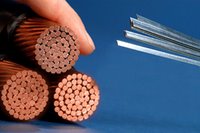 Tuesday's July 25th, 2006 Boston News Radio picked up American Superconductor's announcement of - if we were to believe the lead in - the panacea for an overloaded grid, preventing brownout conditions. The requisite sound bite from AMSC's Dr. Gregory Yurek reiterated the impact of this advance on preventing brownouts. I waited to hear what this silver (or perhaps copper-clad) bullet could be.
Tuesday's July 25th, 2006 Boston News Radio picked up American Superconductor's announcement of - if we were to believe the lead in - the panacea for an overloaded grid, preventing brownout conditions. The requisite sound bite from AMSC's Dr. Gregory Yurek reiterated the impact of this advance on preventing brownouts. I waited to hear what this silver (or perhaps copper-clad) bullet could be.
It's wire. Yes, wire, but not just any plain-old wire. This is second generation (2G) high temperature superconductor (HTS), a.k.a. 344 superconductors, being ultra thin (read: capable of high power density) and also 100% conductive at balmy liquid nitrogen temperatures. You won't be retro-wiring with this on your next kitchen remodel, but Mike Hervey of Long Island Power Authority (LIPA) is quoted as saying a length of it will be installed as a power transmission cable capable of carrying "600 megawatts of power - enough electricity to power 300,000 homes."
How long a length may be one issue. AMSC has demonstrated transmission of commercial levels of current over 300 feet, which is not quite enough to span even the most dense neighborhood of 300,000 row houses. How much cost may be another issue. One 2G HTS cable will replace 100 of its copper cousins, but it won't cost less. But AMSC has made the leap from the lab to the field, and predicts the cost of its 2G HTS wire will break even with copper by the end of the decade.
What about the brownouts? The key issue is the amazing power density of this stuff can more easily increase the grid capacity in highly congested power grids than conventional methods. Another side effect of their perfect conductivity (am I correct here?) is that their voltage stability limit must be near their capacity. Most 20th century cables are run at about half of their thermal limit. Drive them higher during peak demand times, and risk voltage instability. Keep it cool, and keep your voltage. So if ya wanna reduce brownouts, ya still gotta go build out the grid.
Q. To what degree do power outages affect your quality of life?
Photo source: American Superconductor.
Friday, July 28, 2006
2G HTS Wire to Boost Capacity of Grid?
Posted by
James D. McNamara, PMP
at
9:00 PM
0
comments
![]()
Labels: American Superconductor, HTS, superconductor
Thursday, April 27, 2006
Free 411 info on call if you'll listen to ads
 Have I finally found a solution for the blatantly usurious fees charged by my mobile services provider? For that matter, by my landline POTS grifters as well? It seems if I'm willing to provide a few seconds of marketing eyeballs—or in this case ears—the answer seems to be a resounding yes.
Have I finally found a solution for the blatantly usurious fees charged by my mobile services provider? For that matter, by my landline POTS grifters as well? It seems if I'm willing to provide a few seconds of marketing eyeballs—or in this case ears—the answer seems to be a resounding yes.
USA Today reports on several no-charge "411" directory services. The round-up includes:
- 1-800-411-SAVE
- 1-800-FREE-411
- 1-800-411-METRO
Posted by
James D. McNamara, PMP
at
6:00 PM
0
comments
![]()
Labels: 411, phone directory
Friday, February 25, 2005
Broadband PCS Spectrum Auction Closes; Winning Bidders Announced for Auction No. 58
 FCC Auction 58 has ended, and companies have bid generously (greedily?) for the rights to bring Broadband PCS content to a handset near you. (Refer to Attachment A for the winners.) Over $2B was bid, spreading 217 licenses over 24 bidders, among 35 participants.
FCC Auction 58 has ended, and companies have bid generously (greedily?) for the rights to bring Broadband PCS content to a handset near you. (Refer to Attachment A for the winners.) Over $2B was bid, spreading 217 licenses over 24 bidders, among 35 participants.
It is hard to wrap my mind around these sums, which don't include the cost of infrastructure to actually use the bandwidth. As with any fixed resource with high demand, the clash of Keynesian economics and Auction Theory combined to provide large windfalls of cash to the FCC.
Q. Who can trace the legal ownership of wireless spectrum in the U.S. to the FCC?
Posted by
James D. McNamara, PMP
at
11:00 PM
0
comments
![]()